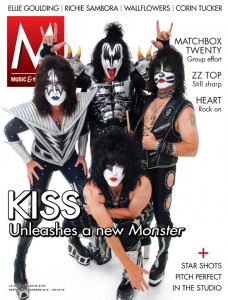Russell Hall | Music & Musicians
 For a long time, beginning in 1999, Paul Stanley wasn’t sure Kiss would make another studio album. Worse, he wasn’t sure he wanted to. Ironically, it was the making of the previous year’s Psycho Circus—the much-ballyhooed record that featured original members Peter Criss and Ace Frehley reunited with Kiss founders Stanley and Gene Simmons—that put Stanley in that frame of mind. As he tells it, Criss and Frehley were recalcitrant participants, at best.
For a long time, beginning in 1999, Paul Stanley wasn’t sure Kiss would make another studio album. Worse, he wasn’t sure he wanted to. Ironically, it was the making of the previous year’s Psycho Circus—the much-ballyhooed record that featured original members Peter Criss and Ace Frehley reunited with Kiss founders Stanley and Gene Simmons—that put Stanley in that frame of mind. As he tells it, Criss and Frehley were recalcitrant participants, at best.
“What we learned is that you can’t make a great Kiss album without Kiss,” he says. “When there are two people in the studio working, and two who are refusing to come in, or who have their attorneys on the phone all the time, that’s not a good situation. Psycho Circus was interesting in the sense that it made me never want to go back into the studio, and at the same time, I felt I’ll be damned if that was going to be the last album we made. The band, during the reunion period, went south pretty quickly. It was something we managed to keep alive in much the same way a paramedic might keep a stroke victim from dying.”
To say Stanley and Simmons have kept Kiss alive is an understatement. Since the group’s 1974 self-titled debut, Kiss has released 20 studio albums, 10 live records and 13 compilation discs. Including solo records, they’ve been awarded 28 gold albums, more than any American rock group. Worldwide album sales are colossal—more than 100 million.
There’s another facet to that success—the group’s merchandising empire, and it’s unrivalled in rock. The Kiss brand offers everything from baby bibs to action figures to caskets (spelled Kaskets, of course). There’s also a miniature golf course, a coffeehouse and even a Kiss Kruise. The vast array of goods is served up without apology. “It all begins with the songs, no question about that,” says Simmons. “But there were never any rules for being in a rock band. People just thought there were. For us, it’s not enough to just be a Radiohead or a U2. That’s why we have 3,000 licensed products.”
Kiss continued to tour after Psycho Circus, albeit in ever-changing configurations. Criss left in 2001, replaced by Eric Singer, who had previously served as the band’s drummer in the early ’90s. Frehley departed the following year, and longtime Kiss associate Tommy Thayer stepped in as replacement on lead guitar. Thayer’s position was made permanent, but in 2003 Criss returned for KISS Symphony: Alive IV, a concert album with Australia’s Melbourne Symphony Orchestra. A year later, Criss was out, Singer was back.
Since then, the lineup of Stanley, Simmons, Thayer and Singer has coalesced into a finely tuned rock machine that has achieved its greatest success on the road. World tours in 2008 and 2009 solidified the group’s status as a premier live act, as the band’s chemistry rose to a level commensurate with the group’s spectacular stage show. In 2010—following a decade of resistance to the idea—Kiss released Sonic Boom, a no-frills studio album that captured the band’s sound from their mid-’70s heyday.
Kiss’ latest, Monster—produced by Stanley and production vet Greg Collins—fully embraces a stripped-down, back-to-basics approach. “No boys’ choirs, no symphony orchestras, just meat and potatoes,” says Simmons, alluding to the adherence to two guitars, bass and drums. The goal? Raise the bar while keeping things simple. “We sat facing each other as we recorded,” he says. “The idea was to get things in the first, second or third take. I didn’t want to lose any of the urgency and passion of what we were doing.”
